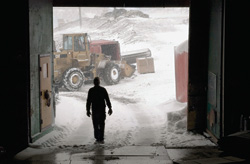|
Wondrous Cold: An Antarctic Journey opens at the Burke Museum on October 3 and remains on view through November 29, 2009. Developed by the Smithsonian Institution Traveling Exhibition Service, Wondrous Cold features the photography of Joan Myers, who spent October 2002 through January 2003 in Antarctica. Real Antarctic camp equipment, fossils, and research findings from scientists at the University of Washington will accompany Myer's photography at the Burke.
Actual camp gear, such as a skidoo, tent, and cold-weather clothing, will show what it takes to survive and work in extreme Antarctic conditions. Learn about paleontological and geological research being conducted in Antarctica by University of Washington scientists. See real Antarctic fossils, such as a giant prehistoric amphibian, being studied by the Burke's curator of vertebrate paleontology, Dr. Christian Sidor, and parts of an Antarctic dinosaur named Cryolophosaurus.Recent UW research on Antarctic climate change will also be highlighted with a display of lab equipment used to analyze ice cores.
Fifty of Joan Myers' color and black-and-white photographs place the work of UW's Antarctic researchers into a greater context. Myers' photographs juxtapose large panoramas of Antarctica's austere beauty and inhuman scale with wildlife, people, and the abandoned huts of early explorers Robert Falcon Scott and Ernest Shackleton. Explore how scientists conduct research in climatology, glaciology, biology and astronomy at the American scientific research station McMurdo Station, and learn about the support staff that keeps the station functioning. From the South Pole to the top of Mt. Erebus, to McMurdo Station, Myers photographed in below freezing temperatures, with wind chills as low as -84 degrees Fahrenheit. Wondrous Cold transports museum visitors to places where extreme conditions prevent most people from ever visiting.
|

Waste barn at McMurdo Station
Photo by Joan Myers |

